HLTAAP002 Confirm Physical Health Status Assessment
VerifiedAdded on 2021/08/04
|16
|5677
|96
AI Summary
This document is Assessment 2 of the two assessments you are required to complete, together with structured workplace learning, for HLTAAP002 Confirm physical health status. This assessment is designed to gather evidence of competence, specifically to obtain information about physical health status, check physical health status, and identify variations from normal physical health status.
Contribute Materials
Your contribution can guide someone’s learning journey. Share your
documents today.
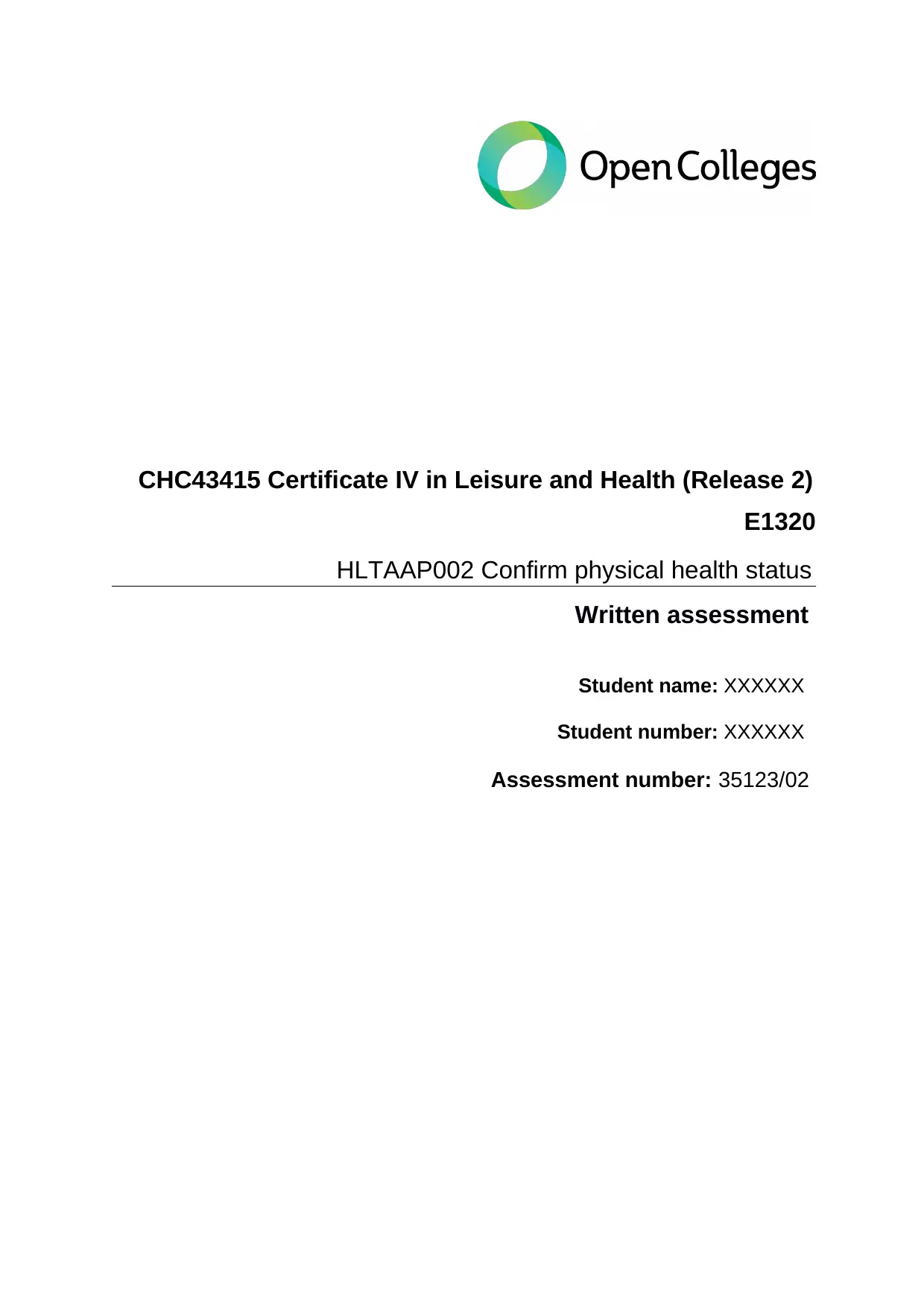
CHC43415 Certificate IV in Leisure and Health (Release 2)
E1320
HLTAAP002 Confirm physical health status
Written assessment
Student name: XXXXXX
Student number: XXXXXX
Assessment number: 35123/02
E1320
HLTAAP002 Confirm physical health status
Written assessment
Student name: XXXXXX
Student number: XXXXXX
Assessment number: 35123/02
Secure Best Marks with AI Grader
Need help grading? Try our AI Grader for instant feedback on your assignments.
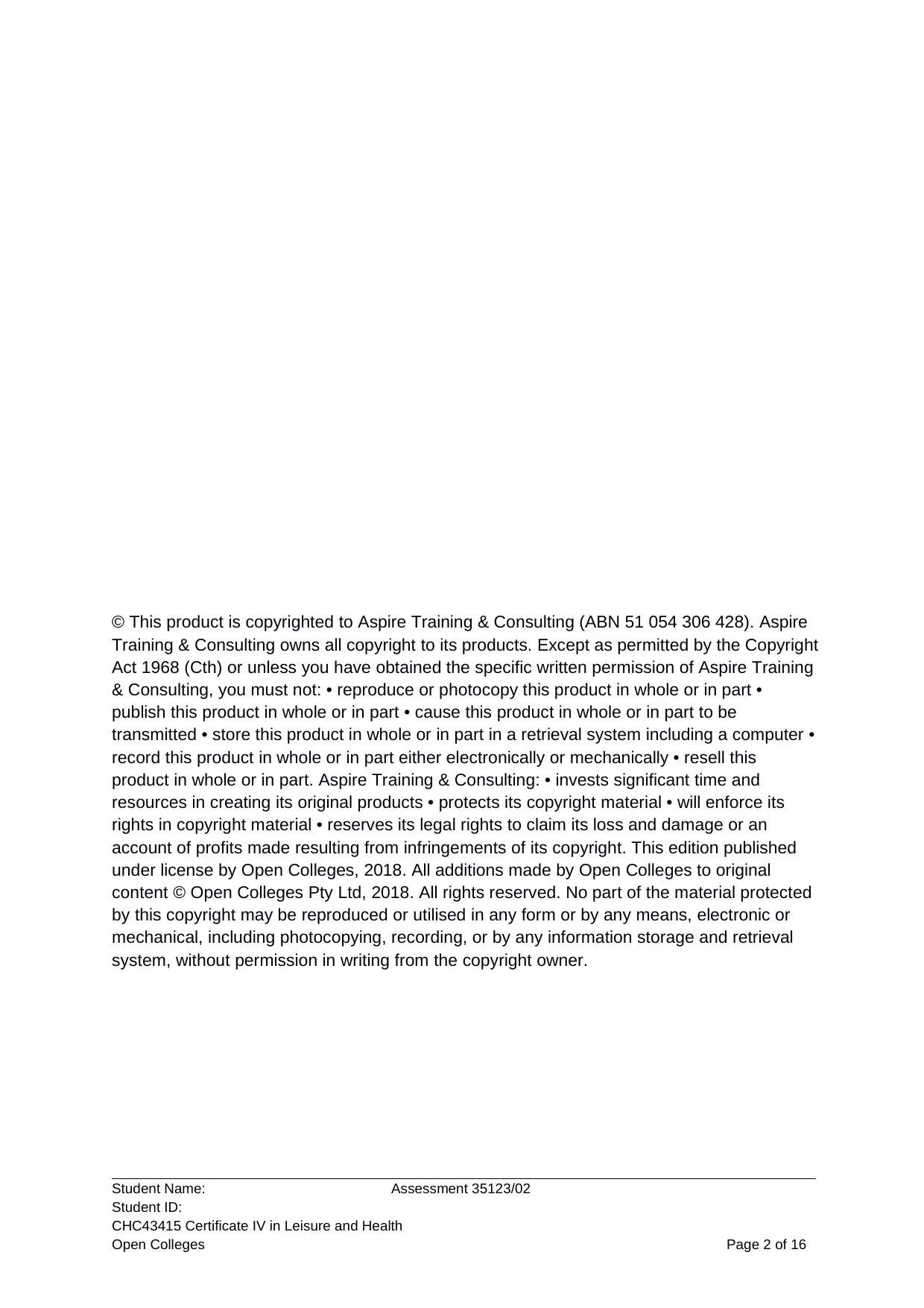
© This product is copyrighted to Aspire Training & Consulting (ABN 51 054 306 428). Aspire
Training & Consulting owns all copyright to its products. Except as permitted by the Copyright
Act 1968 (Cth) or unless you have obtained the specific written permission of Aspire Training
& Consulting, you must not: • reproduce or photocopy this product in whole or in part •
publish this product in whole or in part • cause this product in whole or in part to be
transmitted • store this product in whole or in part in a retrieval system including a computer •
record this product in whole or in part either electronically or mechanically • resell this
product in whole or in part. Aspire Training & Consulting: • invests significant time and
resources in creating its original products • protects its copyright material • will enforce its
rights in copyright material • reserves its legal rights to claim its loss and damage or an
account of profits made resulting from infringements of its copyright. This edition published
under license by Open Colleges, 2018. All additions made by Open Colleges to original
content © Open Colleges Pty Ltd, 2018. All rights reserved. No part of the material protected
by this copyright may be reproduced or utilised in any form or by any means, electronic or
mechanical, including photocopying, recording, or by any information storage and retrieval
system, without permission in writing from the copyright owner.
Student Name: Assessment 35123/02
Student ID:
CHC43415 Certificate IV in Leisure and Health
Open Colleges Page 2 of 16
Training & Consulting owns all copyright to its products. Except as permitted by the Copyright
Act 1968 (Cth) or unless you have obtained the specific written permission of Aspire Training
& Consulting, you must not: • reproduce or photocopy this product in whole or in part •
publish this product in whole or in part • cause this product in whole or in part to be
transmitted • store this product in whole or in part in a retrieval system including a computer •
record this product in whole or in part either electronically or mechanically • resell this
product in whole or in part. Aspire Training & Consulting: • invests significant time and
resources in creating its original products • protects its copyright material • will enforce its
rights in copyright material • reserves its legal rights to claim its loss and damage or an
account of profits made resulting from infringements of its copyright. This edition published
under license by Open Colleges, 2018. All additions made by Open Colleges to original
content © Open Colleges Pty Ltd, 2018. All rights reserved. No part of the material protected
by this copyright may be reproduced or utilised in any form or by any means, electronic or
mechanical, including photocopying, recording, or by any information storage and retrieval
system, without permission in writing from the copyright owner.
Student Name: Assessment 35123/02
Student ID:
CHC43415 Certificate IV in Leisure and Health
Open Colleges Page 2 of 16
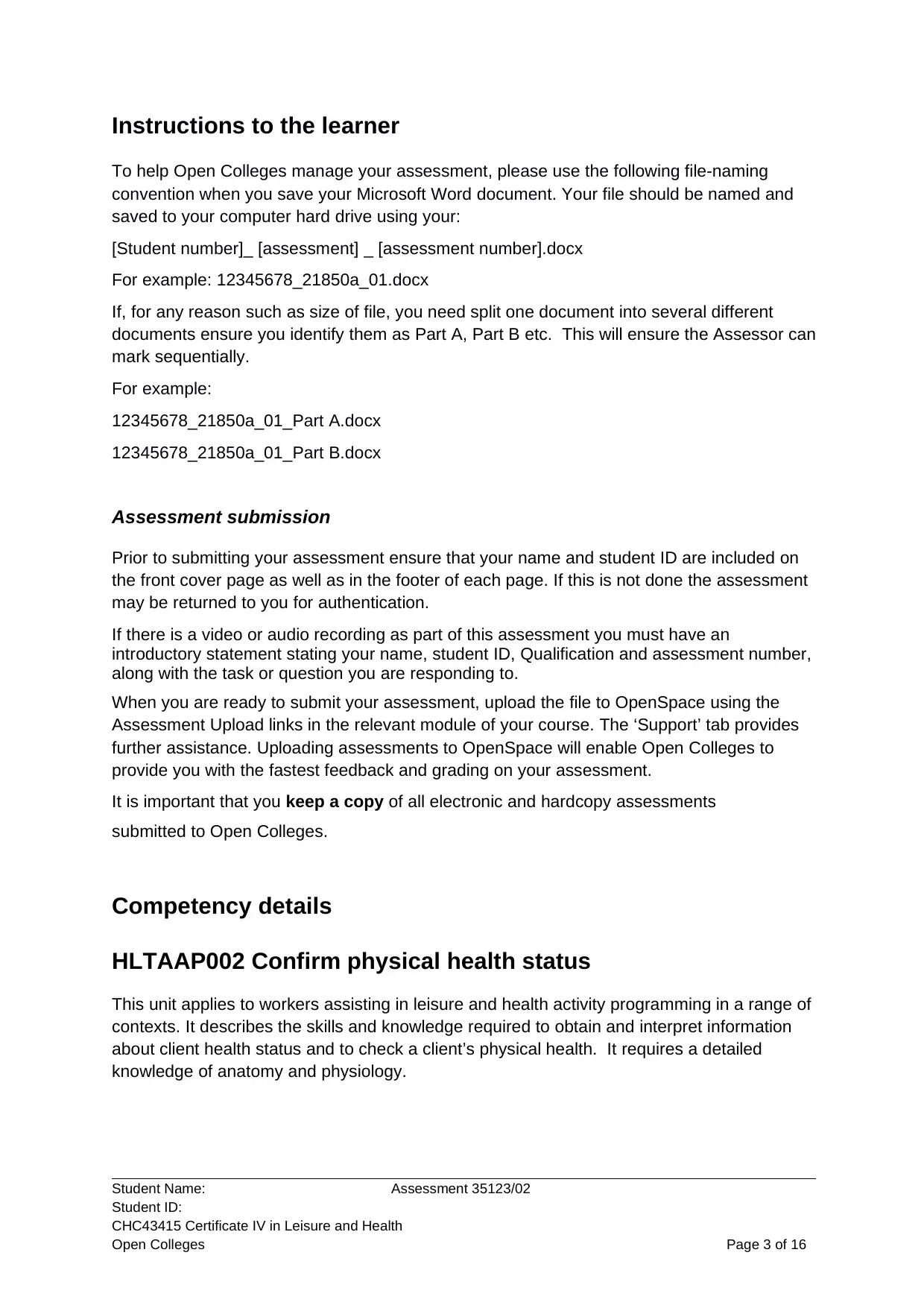
Instructions to the learner
To help Open Colleges manage your assessment, please use the following file-naming
convention when you save your Microsoft Word document. Your file should be named and
saved to your computer hard drive using your:
[Student number]_ [assessment] _ [assessment number].docx
For example: 12345678_21850a_01.docx
If, for any reason such as size of file, you need split one document into several different
documents ensure you identify them as Part A, Part B etc. This will ensure the Assessor can
mark sequentially.
For example:
12345678_21850a_01_Part A.docx
12345678_21850a_01_Part B.docx
Assessment submission
Prior to submitting your assessment ensure that your name and student ID are included on
the front cover page as well as in the footer of each page. If this is not done the assessment
may be returned to you for authentication.
If there is a video or audio recording as part of this assessment you must have an
introductory statement stating your name, student ID, Qualification and assessment number,
along with the task or question you are responding to.
When you are ready to submit your assessment, upload the file to OpenSpace using the
Assessment Upload links in the relevant module of your course. The ‘Support’ tab provides
further assistance. Uploading assessments to OpenSpace will enable Open Colleges to
provide you with the fastest feedback and grading on your assessment.
It is important that you keep a copy of all electronic and hardcopy assessments
submitted to Open Colleges.
Competency details
HLTAAP002 Confirm physical health status
This unit applies to workers assisting in leisure and health activity programming in a range of
contexts. It describes the skills and knowledge required to obtain and interpret information
about client health status and to check a client’s physical health. It requires a detailed
knowledge of anatomy and physiology.
Student Name: Assessment 35123/02
Student ID:
CHC43415 Certificate IV in Leisure and Health
Open Colleges Page 3 of 16
To help Open Colleges manage your assessment, please use the following file-naming
convention when you save your Microsoft Word document. Your file should be named and
saved to your computer hard drive using your:
[Student number]_ [assessment] _ [assessment number].docx
For example: 12345678_21850a_01.docx
If, for any reason such as size of file, you need split one document into several different
documents ensure you identify them as Part A, Part B etc. This will ensure the Assessor can
mark sequentially.
For example:
12345678_21850a_01_Part A.docx
12345678_21850a_01_Part B.docx
Assessment submission
Prior to submitting your assessment ensure that your name and student ID are included on
the front cover page as well as in the footer of each page. If this is not done the assessment
may be returned to you for authentication.
If there is a video or audio recording as part of this assessment you must have an
introductory statement stating your name, student ID, Qualification and assessment number,
along with the task or question you are responding to.
When you are ready to submit your assessment, upload the file to OpenSpace using the
Assessment Upload links in the relevant module of your course. The ‘Support’ tab provides
further assistance. Uploading assessments to OpenSpace will enable Open Colleges to
provide you with the fastest feedback and grading on your assessment.
It is important that you keep a copy of all electronic and hardcopy assessments
submitted to Open Colleges.
Competency details
HLTAAP002 Confirm physical health status
This unit applies to workers assisting in leisure and health activity programming in a range of
contexts. It describes the skills and knowledge required to obtain and interpret information
about client health status and to check a client’s physical health. It requires a detailed
knowledge of anatomy and physiology.
Student Name: Assessment 35123/02
Student ID:
CHC43415 Certificate IV in Leisure and Health
Open Colleges Page 3 of 16
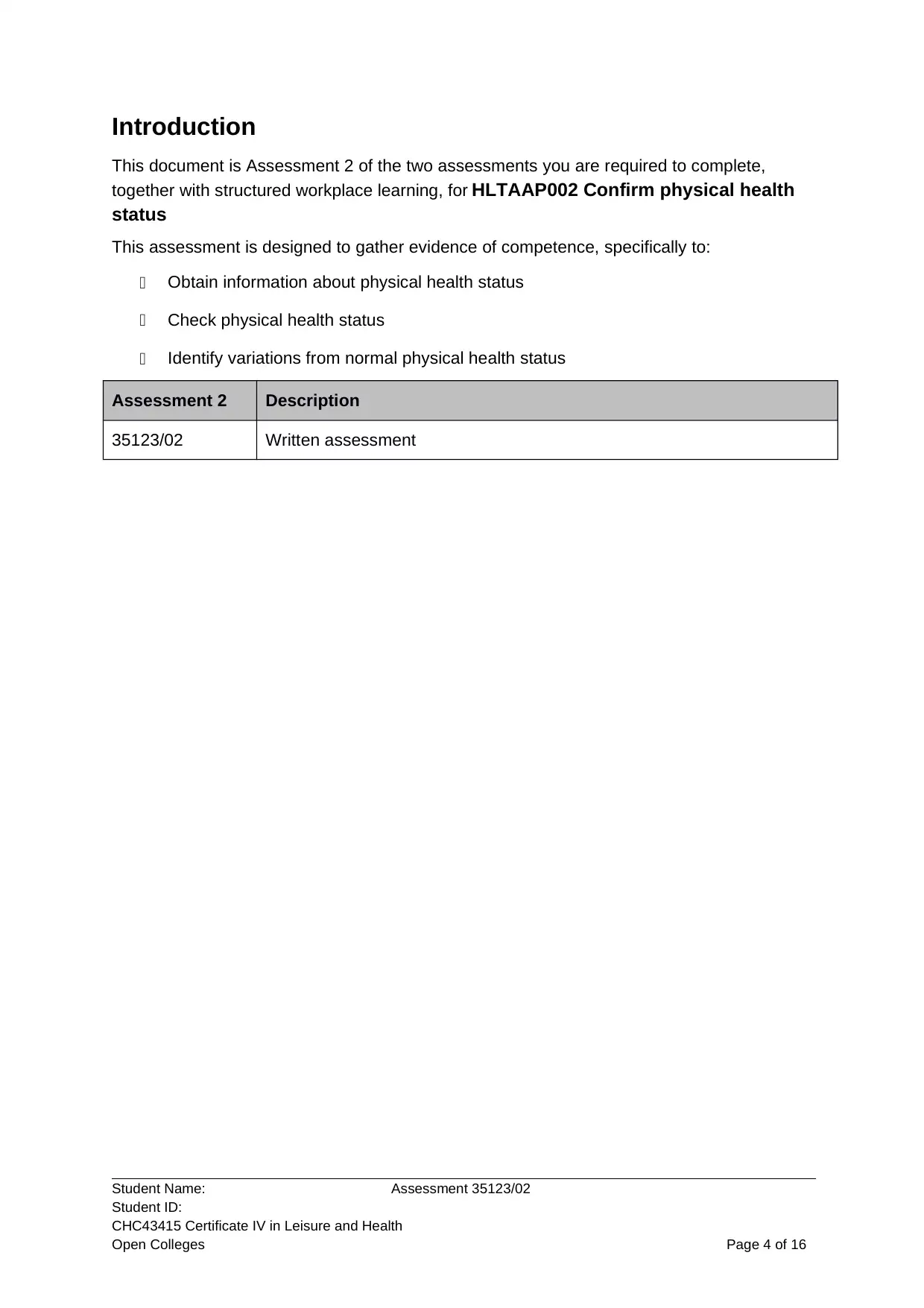
Introduction
This document is Assessment 2 of the two assessments you are required to complete,
together with structured workplace learning, for HLTAAP002 Confirm physical health
status
This assessment is designed to gather evidence of competence, specifically to:
Obtain information about physical health status
Check physical health status
Identify variations from normal physical health status
Assessment 2 Description
35123/02 Written assessment
Student Name: Assessment 35123/02
Student ID:
CHC43415 Certificate IV in Leisure and Health
Open Colleges Page 4 of 16
This document is Assessment 2 of the two assessments you are required to complete,
together with structured workplace learning, for HLTAAP002 Confirm physical health
status
This assessment is designed to gather evidence of competence, specifically to:
Obtain information about physical health status
Check physical health status
Identify variations from normal physical health status
Assessment 2 Description
35123/02 Written assessment
Student Name: Assessment 35123/02
Student ID:
CHC43415 Certificate IV in Leisure and Health
Open Colleges Page 4 of 16
Secure Best Marks with AI Grader
Need help grading? Try our AI Grader for instant feedback on your assignments.
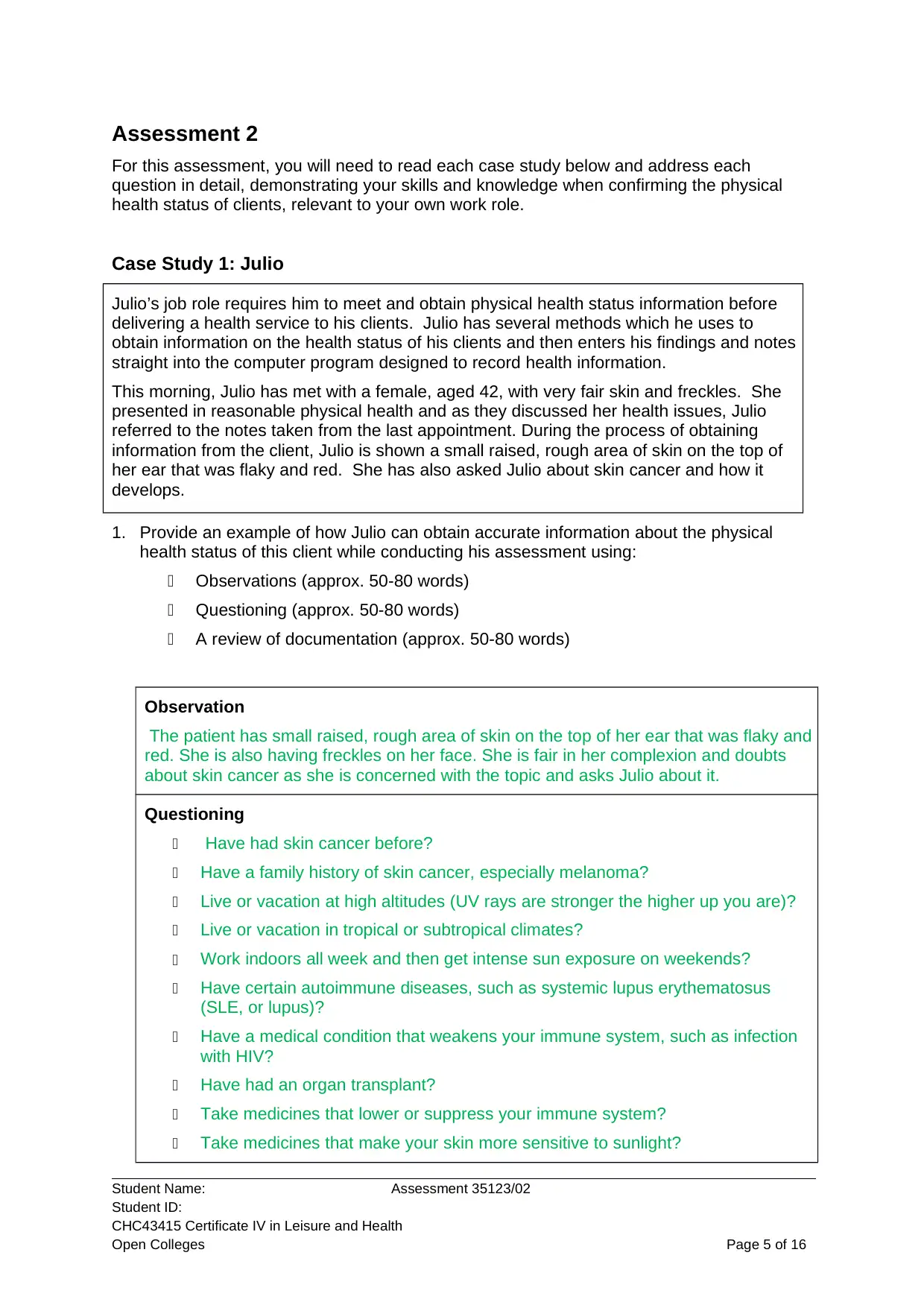
Assessment 2
For this assessment, you will need to read each case study below and address each
question in detail, demonstrating your skills and knowledge when confirming the physical
health status of clients, relevant to your own work role.
Case Study 1: Julio
Julio’s job role requires him to meet and obtain physical health status information before
delivering a health service to his clients. Julio has several methods which he uses to
obtain information on the health status of his clients and then enters his findings and notes
straight into the computer program designed to record health information.
This morning, Julio has met with a female, aged 42, with very fair skin and freckles. She
presented in reasonable physical health and as they discussed her health issues, Julio
referred to the notes taken from the last appointment. During the process of obtaining
information from the client, Julio is shown a small raised, rough area of skin on the top of
her ear that was flaky and red. She has also asked Julio about skin cancer and how it
develops.
1. Provide an example of how Julio can obtain accurate information about the physical
health status of this client while conducting his assessment using:
Observations (approx. 50-80 words)
Questioning (approx. 50-80 words)
A review of documentation (approx. 50-80 words)
Observation
The patient has small raised, rough area of skin on the top of her ear that was flaky and
red. She is also having freckles on her face. She is fair in her complexion and doubts
about skin cancer as she is concerned with the topic and asks Julio about it.
Questioning
Have had skin cancer before?
Have a family history of skin cancer, especially melanoma?
Live or vacation at high altitudes (UV rays are stronger the higher up you are)?
Live or vacation in tropical or subtropical climates?
Work indoors all week and then get intense sun exposure on weekends?
Have certain autoimmune diseases, such as systemic lupus erythematosus
(SLE, or lupus)?
Have a medical condition that weakens your immune system, such as infection
with HIV?
Have had an organ transplant?
Take medicines that lower or suppress your immune system?
Take medicines that make your skin more sensitive to sunlight?
Student Name: Assessment 35123/02
Student ID:
CHC43415 Certificate IV in Leisure and Health
Open Colleges Page 5 of 16
For this assessment, you will need to read each case study below and address each
question in detail, demonstrating your skills and knowledge when confirming the physical
health status of clients, relevant to your own work role.
Case Study 1: Julio
Julio’s job role requires him to meet and obtain physical health status information before
delivering a health service to his clients. Julio has several methods which he uses to
obtain information on the health status of his clients and then enters his findings and notes
straight into the computer program designed to record health information.
This morning, Julio has met with a female, aged 42, with very fair skin and freckles. She
presented in reasonable physical health and as they discussed her health issues, Julio
referred to the notes taken from the last appointment. During the process of obtaining
information from the client, Julio is shown a small raised, rough area of skin on the top of
her ear that was flaky and red. She has also asked Julio about skin cancer and how it
develops.
1. Provide an example of how Julio can obtain accurate information about the physical
health status of this client while conducting his assessment using:
Observations (approx. 50-80 words)
Questioning (approx. 50-80 words)
A review of documentation (approx. 50-80 words)
Observation
The patient has small raised, rough area of skin on the top of her ear that was flaky and
red. She is also having freckles on her face. She is fair in her complexion and doubts
about skin cancer as she is concerned with the topic and asks Julio about it.
Questioning
Have had skin cancer before?
Have a family history of skin cancer, especially melanoma?
Live or vacation at high altitudes (UV rays are stronger the higher up you are)?
Live or vacation in tropical or subtropical climates?
Work indoors all week and then get intense sun exposure on weekends?
Have certain autoimmune diseases, such as systemic lupus erythematosus
(SLE, or lupus)?
Have a medical condition that weakens your immune system, such as infection
with HIV?
Have had an organ transplant?
Take medicines that lower or suppress your immune system?
Take medicines that make your skin more sensitive to sunlight?
Student Name: Assessment 35123/02
Student ID:
CHC43415 Certificate IV in Leisure and Health
Open Colleges Page 5 of 16
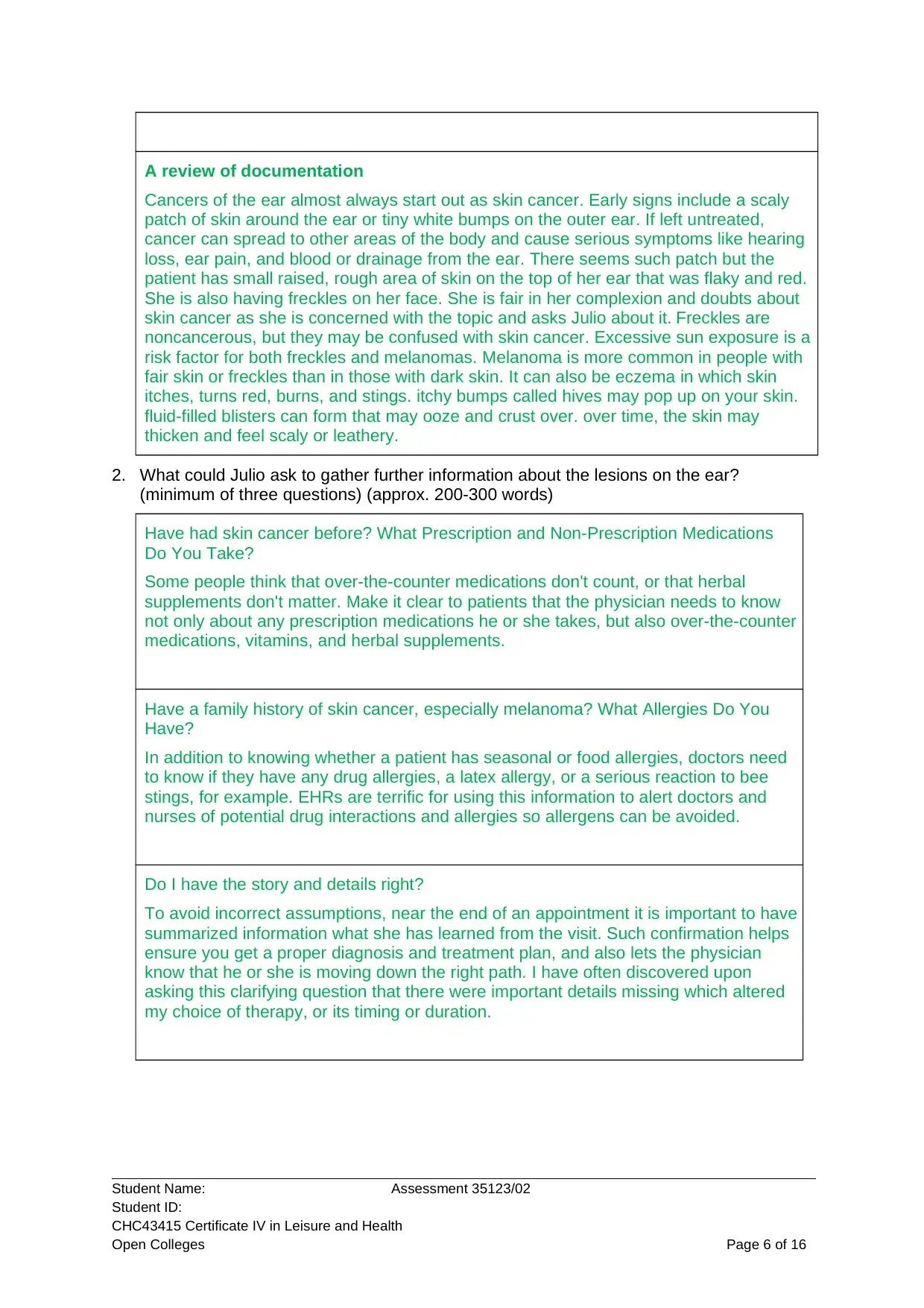
A review of documentation
Cancers of the ear almost always start out as skin cancer. Early signs include a scaly
patch of skin around the ear or tiny white bumps on the outer ear. If left untreated,
cancer can spread to other areas of the body and cause serious symptoms like hearing
loss, ear pain, and blood or drainage from the ear. There seems such patch but the
patient has small raised, rough area of skin on the top of her ear that was flaky and red.
She is also having freckles on her face. She is fair in her complexion and doubts about
skin cancer as she is concerned with the topic and asks Julio about it. Freckles are
noncancerous, but they may be confused with skin cancer. Excessive sun exposure is a
risk factor for both freckles and melanomas. Melanoma is more common in people with
fair skin or freckles than in those with dark skin. It can also be eczema in which skin
itches, turns red, burns, and stings. itchy bumps called hives may pop up on your skin.
fluid-filled blisters can form that may ooze and crust over. over time, the skin may
thicken and feel scaly or leathery.
2. What could Julio ask to gather further information about the lesions on the ear?
(minimum of three questions) (approx. 200-300 words)
Have had skin cancer before? What Prescription and Non-Prescription Medications
Do You Take?
Some people think that over-the-counter medications don't count, or that herbal
supplements don't matter. Make it clear to patients that the physician needs to know
not only about any prescription medications he or she takes, but also over-the-counter
medications, vitamins, and herbal supplements.
Have a family history of skin cancer, especially melanoma? What Allergies Do You
Have?
In addition to knowing whether a patient has seasonal or food allergies, doctors need
to know if they have any drug allergies, a latex allergy, or a serious reaction to bee
stings, for example. EHRs are terrific for using this information to alert doctors and
nurses of potential drug interactions and allergies so allergens can be avoided.
Do I have the story and details right?
To avoid incorrect assumptions, near the end of an appointment it is important to have
summarized information what she has learned from the visit. Such confirmation helps
ensure you get a proper diagnosis and treatment plan, and also lets the physician
know that he or she is moving down the right path. I have often discovered upon
asking this clarifying question that there were important details missing which altered
my choice of therapy, or its timing or duration.
Student Name: Assessment 35123/02
Student ID:
CHC43415 Certificate IV in Leisure and Health
Open Colleges Page 6 of 16
Cancers of the ear almost always start out as skin cancer. Early signs include a scaly
patch of skin around the ear or tiny white bumps on the outer ear. If left untreated,
cancer can spread to other areas of the body and cause serious symptoms like hearing
loss, ear pain, and blood or drainage from the ear. There seems such patch but the
patient has small raised, rough area of skin on the top of her ear that was flaky and red.
She is also having freckles on her face. She is fair in her complexion and doubts about
skin cancer as she is concerned with the topic and asks Julio about it. Freckles are
noncancerous, but they may be confused with skin cancer. Excessive sun exposure is a
risk factor for both freckles and melanomas. Melanoma is more common in people with
fair skin or freckles than in those with dark skin. It can also be eczema in which skin
itches, turns red, burns, and stings. itchy bumps called hives may pop up on your skin.
fluid-filled blisters can form that may ooze and crust over. over time, the skin may
thicken and feel scaly or leathery.
2. What could Julio ask to gather further information about the lesions on the ear?
(minimum of three questions) (approx. 200-300 words)
Have had skin cancer before? What Prescription and Non-Prescription Medications
Do You Take?
Some people think that over-the-counter medications don't count, or that herbal
supplements don't matter. Make it clear to patients that the physician needs to know
not only about any prescription medications he or she takes, but also over-the-counter
medications, vitamins, and herbal supplements.
Have a family history of skin cancer, especially melanoma? What Allergies Do You
Have?
In addition to knowing whether a patient has seasonal or food allergies, doctors need
to know if they have any drug allergies, a latex allergy, or a serious reaction to bee
stings, for example. EHRs are terrific for using this information to alert doctors and
nurses of potential drug interactions and allergies so allergens can be avoided.
Do I have the story and details right?
To avoid incorrect assumptions, near the end of an appointment it is important to have
summarized information what she has learned from the visit. Such confirmation helps
ensure you get a proper diagnosis and treatment plan, and also lets the physician
know that he or she is moving down the right path. I have often discovered upon
asking this clarifying question that there were important details missing which altered
my choice of therapy, or its timing or duration.
Student Name: Assessment 35123/02
Student ID:
CHC43415 Certificate IV in Leisure and Health
Open Colleges Page 6 of 16
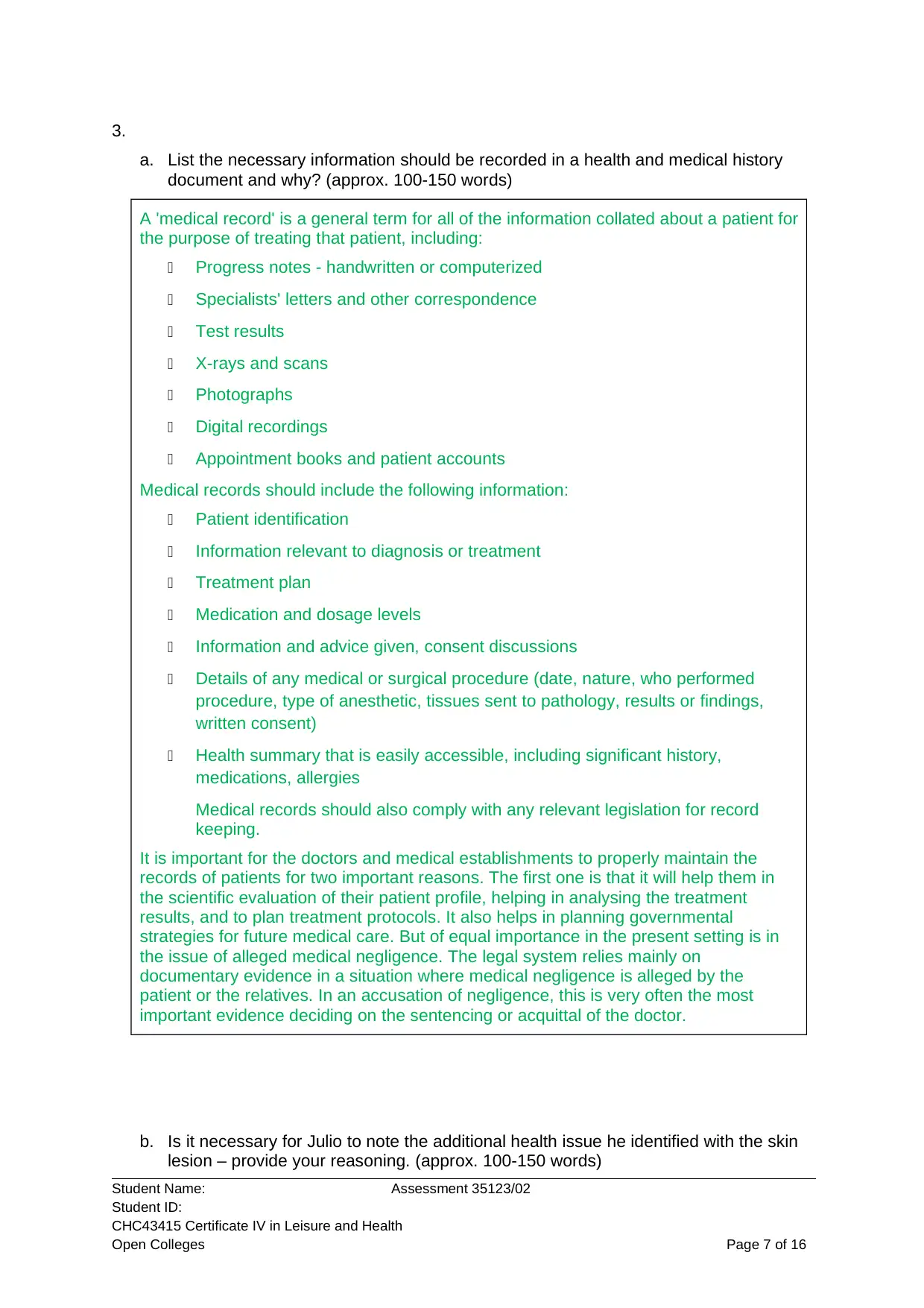
3.
a. List the necessary information should be recorded in a health and medical history
document and why? (approx. 100-150 words)
A 'medical record' is a general term for all of the information collated about a patient for
the purpose of treating that patient, including:
Progress notes - handwritten or computerized
Specialists' letters and other correspondence
Test results
X-rays and scans
Photographs
Digital recordings
Appointment books and patient accounts
Medical records should include the following information:
Patient identification
Information relevant to diagnosis or treatment
Treatment plan
Medication and dosage levels
Information and advice given, consent discussions
Details of any medical or surgical procedure (date, nature, who performed
procedure, type of anesthetic, tissues sent to pathology, results or findings,
written consent)
Health summary that is easily accessible, including significant history,
medications, allergies
Medical records should also comply with any relevant legislation for record
keeping.
It is important for the doctors and medical establishments to properly maintain the
records of patients for two important reasons. The first one is that it will help them in
the scientific evaluation of their patient profile, helping in analysing the treatment
results, and to plan treatment protocols. It also helps in planning governmental
strategies for future medical care. But of equal importance in the present setting is in
the issue of alleged medical negligence. The legal system relies mainly on
documentary evidence in a situation where medical negligence is alleged by the
patient or the relatives. In an accusation of negligence, this is very often the most
important evidence deciding on the sentencing or acquittal of the doctor.
b. Is it necessary for Julio to note the additional health issue he identified with the skin
lesion – provide your reasoning. (approx. 100-150 words)
Student Name: Assessment 35123/02
Student ID:
CHC43415 Certificate IV in Leisure and Health
Open Colleges Page 7 of 16
a. List the necessary information should be recorded in a health and medical history
document and why? (approx. 100-150 words)
A 'medical record' is a general term for all of the information collated about a patient for
the purpose of treating that patient, including:
Progress notes - handwritten or computerized
Specialists' letters and other correspondence
Test results
X-rays and scans
Photographs
Digital recordings
Appointment books and patient accounts
Medical records should include the following information:
Patient identification
Information relevant to diagnosis or treatment
Treatment plan
Medication and dosage levels
Information and advice given, consent discussions
Details of any medical or surgical procedure (date, nature, who performed
procedure, type of anesthetic, tissues sent to pathology, results or findings,
written consent)
Health summary that is easily accessible, including significant history,
medications, allergies
Medical records should also comply with any relevant legislation for record
keeping.
It is important for the doctors and medical establishments to properly maintain the
records of patients for two important reasons. The first one is that it will help them in
the scientific evaluation of their patient profile, helping in analysing the treatment
results, and to plan treatment protocols. It also helps in planning governmental
strategies for future medical care. But of equal importance in the present setting is in
the issue of alleged medical negligence. The legal system relies mainly on
documentary evidence in a situation where medical negligence is alleged by the
patient or the relatives. In an accusation of negligence, this is very often the most
important evidence deciding on the sentencing or acquittal of the doctor.
b. Is it necessary for Julio to note the additional health issue he identified with the skin
lesion – provide your reasoning. (approx. 100-150 words)
Student Name: Assessment 35123/02
Student ID:
CHC43415 Certificate IV in Leisure and Health
Open Colleges Page 7 of 16
Paraphrase This Document
Need a fresh take? Get an instant paraphrase of this document with our AI Paraphraser
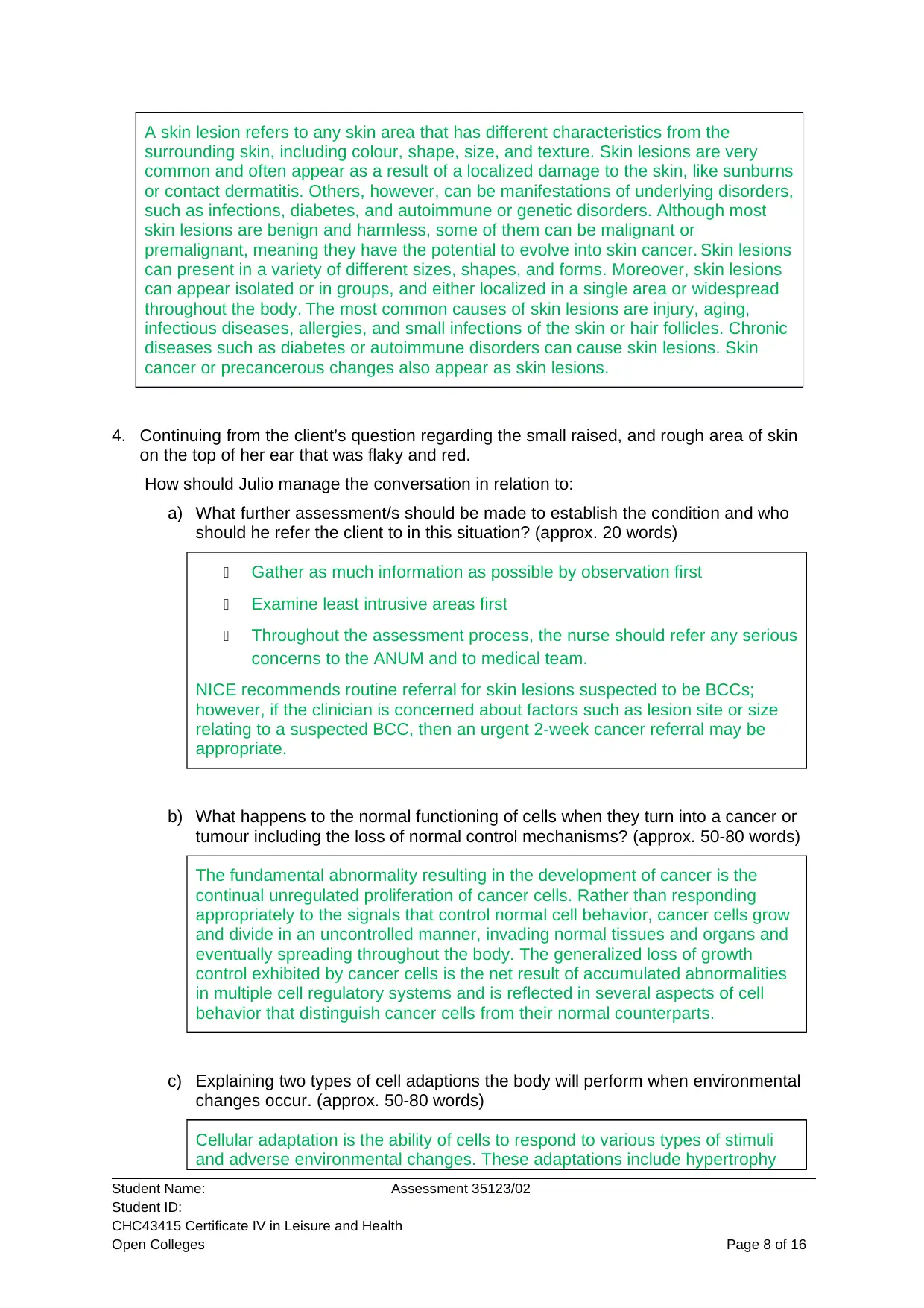
A skin lesion refers to any skin area that has different characteristics from the
surrounding skin, including colour, shape, size, and texture. Skin lesions are very
common and often appear as a result of a localized damage to the skin, like sunburns
or contact dermatitis. Others, however, can be manifestations of underlying disorders,
such as infections, diabetes, and autoimmune or genetic disorders. Although most
skin lesions are benign and harmless, some of them can be malignant or
premalignant, meaning they have the potential to evolve into skin cancer. Skin lesions
can present in a variety of different sizes, shapes, and forms. Moreover, skin lesions
can appear isolated or in groups, and either localized in a single area or widespread
throughout the body. The most common causes of skin lesions are injury, aging,
infectious diseases, allergies, and small infections of the skin or hair follicles. Chronic
diseases such as diabetes or autoimmune disorders can cause skin lesions. Skin
cancer or precancerous changes also appear as skin lesions.
4. Continuing from the client’s question regarding the small raised, and rough area of skin
on the top of her ear that was flaky and red.
How should Julio manage the conversation in relation to:
a) What further assessment/s should be made to establish the condition and who
should he refer the client to in this situation? (approx. 20 words)
Gather as much information as possible by observation first
Examine least intrusive areas first
Throughout the assessment process, the nurse should refer any serious
concerns to the ANUM and to medical team.
NICE recommends routine referral for skin lesions suspected to be BCCs;
however, if the clinician is concerned about factors such as lesion site or size
relating to a suspected BCC, then an urgent 2-week cancer referral may be
appropriate.
b) What happens to the normal functioning of cells when they turn into a cancer or
tumour including the loss of normal control mechanisms? (approx. 50-80 words)
The fundamental abnormality resulting in the development of cancer is the
continual unregulated proliferation of cancer cells. Rather than responding
appropriately to the signals that control normal cell behavior, cancer cells grow
and divide in an uncontrolled manner, invading normal tissues and organs and
eventually spreading throughout the body. The generalized loss of growth
control exhibited by cancer cells is the net result of accumulated abnormalities
in multiple cell regulatory systems and is reflected in several aspects of cell
behavior that distinguish cancer cells from their normal counterparts.
c) Explaining two types of cell adaptions the body will perform when environmental
changes occur. (approx. 50-80 words)
Cellular adaptation is the ability of cells to respond to various types of stimuli
and adverse environmental changes. These adaptations include hypertrophy
Student Name: Assessment 35123/02
Student ID:
CHC43415 Certificate IV in Leisure and Health
Open Colleges Page 8 of 16
surrounding skin, including colour, shape, size, and texture. Skin lesions are very
common and often appear as a result of a localized damage to the skin, like sunburns
or contact dermatitis. Others, however, can be manifestations of underlying disorders,
such as infections, diabetes, and autoimmune or genetic disorders. Although most
skin lesions are benign and harmless, some of them can be malignant or
premalignant, meaning they have the potential to evolve into skin cancer. Skin lesions
can present in a variety of different sizes, shapes, and forms. Moreover, skin lesions
can appear isolated or in groups, and either localized in a single area or widespread
throughout the body. The most common causes of skin lesions are injury, aging,
infectious diseases, allergies, and small infections of the skin or hair follicles. Chronic
diseases such as diabetes or autoimmune disorders can cause skin lesions. Skin
cancer or precancerous changes also appear as skin lesions.
4. Continuing from the client’s question regarding the small raised, and rough area of skin
on the top of her ear that was flaky and red.
How should Julio manage the conversation in relation to:
a) What further assessment/s should be made to establish the condition and who
should he refer the client to in this situation? (approx. 20 words)
Gather as much information as possible by observation first
Examine least intrusive areas first
Throughout the assessment process, the nurse should refer any serious
concerns to the ANUM and to medical team.
NICE recommends routine referral for skin lesions suspected to be BCCs;
however, if the clinician is concerned about factors such as lesion site or size
relating to a suspected BCC, then an urgent 2-week cancer referral may be
appropriate.
b) What happens to the normal functioning of cells when they turn into a cancer or
tumour including the loss of normal control mechanisms? (approx. 50-80 words)
The fundamental abnormality resulting in the development of cancer is the
continual unregulated proliferation of cancer cells. Rather than responding
appropriately to the signals that control normal cell behavior, cancer cells grow
and divide in an uncontrolled manner, invading normal tissues and organs and
eventually spreading throughout the body. The generalized loss of growth
control exhibited by cancer cells is the net result of accumulated abnormalities
in multiple cell regulatory systems and is reflected in several aspects of cell
behavior that distinguish cancer cells from their normal counterparts.
c) Explaining two types of cell adaptions the body will perform when environmental
changes occur. (approx. 50-80 words)
Cellular adaptation is the ability of cells to respond to various types of stimuli
and adverse environmental changes. These adaptations include hypertrophy
Student Name: Assessment 35123/02
Student ID:
CHC43415 Certificate IV in Leisure and Health
Open Colleges Page 8 of 16
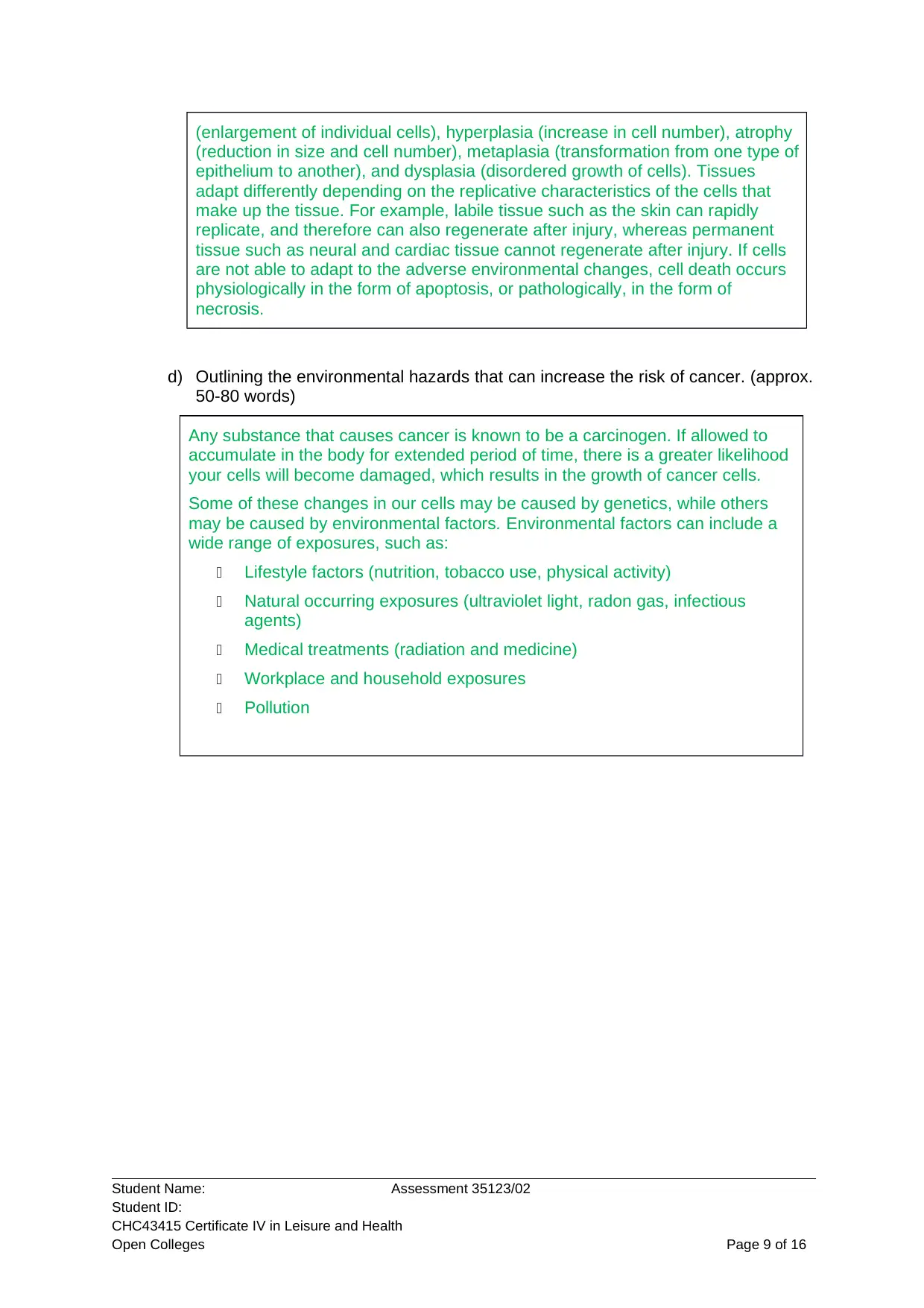
(enlargement of individual cells), hyperplasia (increase in cell number), atrophy
(reduction in size and cell number), metaplasia (transformation from one type of
epithelium to another), and dysplasia (disordered growth of cells). Tissues
adapt differently depending on the replicative characteristics of the cells that
make up the tissue. For example, labile tissue such as the skin can rapidly
replicate, and therefore can also regenerate after injury, whereas permanent
tissue such as neural and cardiac tissue cannot regenerate after injury. If cells
are not able to adapt to the adverse environmental changes, cell death occurs
physiologically in the form of apoptosis, or pathologically, in the form of
necrosis.
d) Outlining the environmental hazards that can increase the risk of cancer. (approx.
50-80 words)
Any substance that causes cancer is known to be a carcinogen. If allowed to
accumulate in the body for extended period of time, there is a greater likelihood
your cells will become damaged, which results in the growth of cancer cells.
Some of these changes in our cells may be caused by genetics, while others
may be caused by environmental factors. Environmental factors can include a
wide range of exposures, such as:
Lifestyle factors (nutrition, tobacco use, physical activity)
Natural occurring exposures (ultraviolet light, radon gas, infectious
agents)
Medical treatments (radiation and medicine)
Workplace and household exposures
Pollution
Student Name: Assessment 35123/02
Student ID:
CHC43415 Certificate IV in Leisure and Health
Open Colleges Page 9 of 16
(reduction in size and cell number), metaplasia (transformation from one type of
epithelium to another), and dysplasia (disordered growth of cells). Tissues
adapt differently depending on the replicative characteristics of the cells that
make up the tissue. For example, labile tissue such as the skin can rapidly
replicate, and therefore can also regenerate after injury, whereas permanent
tissue such as neural and cardiac tissue cannot regenerate after injury. If cells
are not able to adapt to the adverse environmental changes, cell death occurs
physiologically in the form of apoptosis, or pathologically, in the form of
necrosis.
d) Outlining the environmental hazards that can increase the risk of cancer. (approx.
50-80 words)
Any substance that causes cancer is known to be a carcinogen. If allowed to
accumulate in the body for extended period of time, there is a greater likelihood
your cells will become damaged, which results in the growth of cancer cells.
Some of these changes in our cells may be caused by genetics, while others
may be caused by environmental factors. Environmental factors can include a
wide range of exposures, such as:
Lifestyle factors (nutrition, tobacco use, physical activity)
Natural occurring exposures (ultraviolet light, radon gas, infectious
agents)
Medical treatments (radiation and medicine)
Workplace and household exposures
Pollution
Student Name: Assessment 35123/02
Student ID:
CHC43415 Certificate IV in Leisure and Health
Open Colleges Page 9 of 16
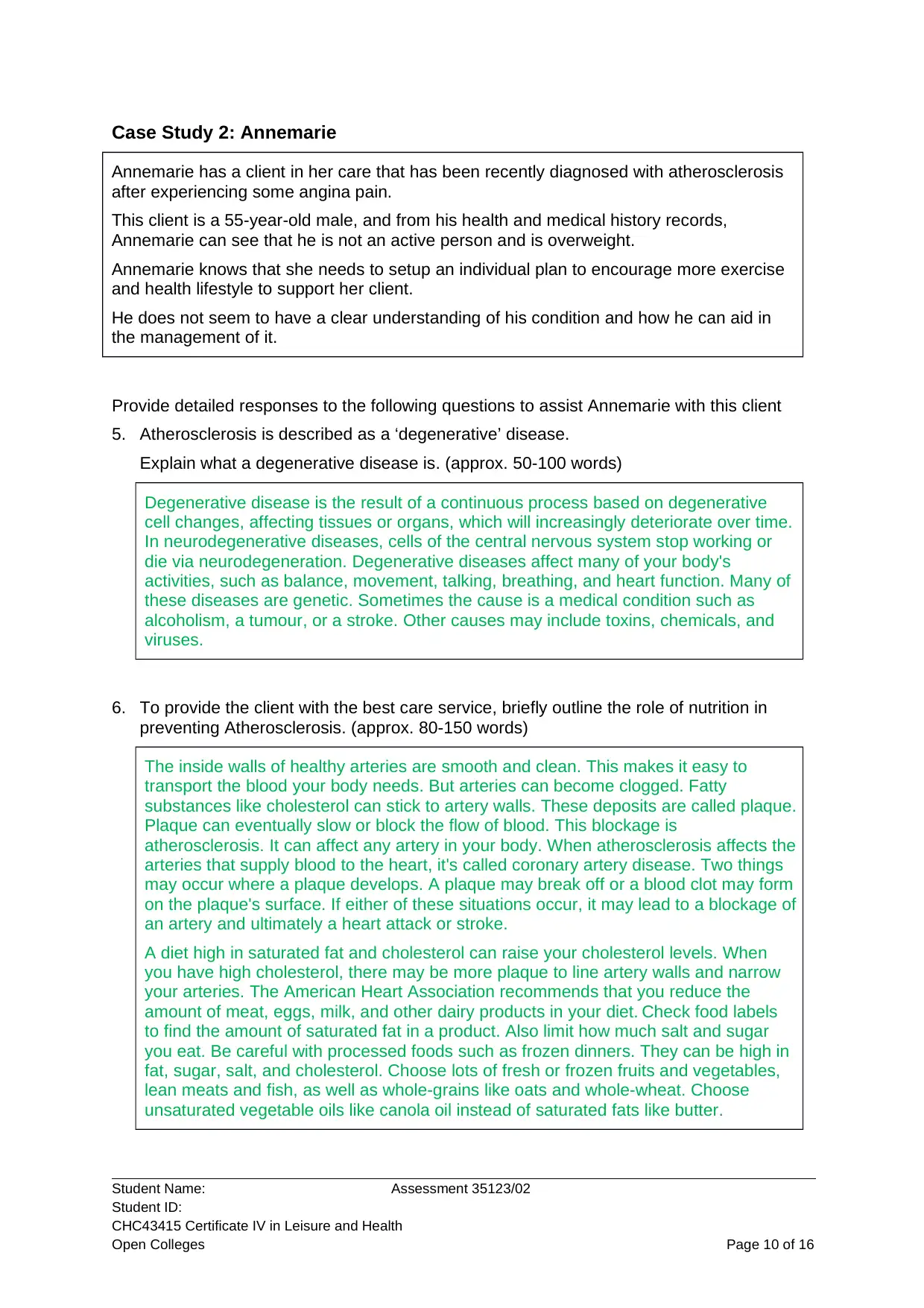
Case Study 2: Annemarie
Annemarie has a client in her care that has been recently diagnosed with atherosclerosis
after experiencing some angina pain.
This client is a 55-year-old male, and from his health and medical history records,
Annemarie can see that he is not an active person and is overweight.
Annemarie knows that she needs to setup an individual plan to encourage more exercise
and health lifestyle to support her client.
He does not seem to have a clear understanding of his condition and how he can aid in
the management of it.
Provide detailed responses to the following questions to assist Annemarie with this client
5. Atherosclerosis is described as a ‘degenerative’ disease.
Explain what a degenerative disease is. (approx. 50-100 words)
Degenerative disease is the result of a continuous process based on degenerative
cell changes, affecting tissues or organs, which will increasingly deteriorate over time.
In neurodegenerative diseases, cells of the central nervous system stop working or
die via neurodegeneration. Degenerative diseases affect many of your body's
activities, such as balance, movement, talking, breathing, and heart function. Many of
these diseases are genetic. Sometimes the cause is a medical condition such as
alcoholism, a tumour, or a stroke. Other causes may include toxins, chemicals, and
viruses.
6. To provide the client with the best care service, briefly outline the role of nutrition in
preventing Atherosclerosis. (approx. 80-150 words)
The inside walls of healthy arteries are smooth and clean. This makes it easy to
transport the blood your body needs. But arteries can become clogged. Fatty
substances like cholesterol can stick to artery walls. These deposits are called plaque.
Plaque can eventually slow or block the flow of blood. This blockage is
atherosclerosis. It can affect any artery in your body. When atherosclerosis affects the
arteries that supply blood to the heart, it's called coronary artery disease. Two things
may occur where a plaque develops. A plaque may break off or a blood clot may form
on the plaque's surface. If either of these situations occur, it may lead to a blockage of
an artery and ultimately a heart attack or stroke.
A diet high in saturated fat and cholesterol can raise your cholesterol levels. When
you have high cholesterol, there may be more plaque to line artery walls and narrow
your arteries. The American Heart Association recommends that you reduce the
amount of meat, eggs, milk, and other dairy products in your diet. Check food labels
to find the amount of saturated fat in a product. Also limit how much salt and sugar
you eat. Be careful with processed foods such as frozen dinners. They can be high in
fat, sugar, salt, and cholesterol. Choose lots of fresh or frozen fruits and vegetables,
lean meats and fish, as well as whole-grains like oats and whole-wheat. Choose
unsaturated vegetable oils like canola oil instead of saturated fats like butter.
Student Name: Assessment 35123/02
Student ID:
CHC43415 Certificate IV in Leisure and Health
Open Colleges Page 10 of 16
Annemarie has a client in her care that has been recently diagnosed with atherosclerosis
after experiencing some angina pain.
This client is a 55-year-old male, and from his health and medical history records,
Annemarie can see that he is not an active person and is overweight.
Annemarie knows that she needs to setup an individual plan to encourage more exercise
and health lifestyle to support her client.
He does not seem to have a clear understanding of his condition and how he can aid in
the management of it.
Provide detailed responses to the following questions to assist Annemarie with this client
5. Atherosclerosis is described as a ‘degenerative’ disease.
Explain what a degenerative disease is. (approx. 50-100 words)
Degenerative disease is the result of a continuous process based on degenerative
cell changes, affecting tissues or organs, which will increasingly deteriorate over time.
In neurodegenerative diseases, cells of the central nervous system stop working or
die via neurodegeneration. Degenerative diseases affect many of your body's
activities, such as balance, movement, talking, breathing, and heart function. Many of
these diseases are genetic. Sometimes the cause is a medical condition such as
alcoholism, a tumour, or a stroke. Other causes may include toxins, chemicals, and
viruses.
6. To provide the client with the best care service, briefly outline the role of nutrition in
preventing Atherosclerosis. (approx. 80-150 words)
The inside walls of healthy arteries are smooth and clean. This makes it easy to
transport the blood your body needs. But arteries can become clogged. Fatty
substances like cholesterol can stick to artery walls. These deposits are called plaque.
Plaque can eventually slow or block the flow of blood. This blockage is
atherosclerosis. It can affect any artery in your body. When atherosclerosis affects the
arteries that supply blood to the heart, it's called coronary artery disease. Two things
may occur where a plaque develops. A plaque may break off or a blood clot may form
on the plaque's surface. If either of these situations occur, it may lead to a blockage of
an artery and ultimately a heart attack or stroke.
A diet high in saturated fat and cholesterol can raise your cholesterol levels. When
you have high cholesterol, there may be more plaque to line artery walls and narrow
your arteries. The American Heart Association recommends that you reduce the
amount of meat, eggs, milk, and other dairy products in your diet. Check food labels
to find the amount of saturated fat in a product. Also limit how much salt and sugar
you eat. Be careful with processed foods such as frozen dinners. They can be high in
fat, sugar, salt, and cholesterol. Choose lots of fresh or frozen fruits and vegetables,
lean meats and fish, as well as whole-grains like oats and whole-wheat. Choose
unsaturated vegetable oils like canola oil instead of saturated fats like butter.
Student Name: Assessment 35123/02
Student ID:
CHC43415 Certificate IV in Leisure and Health
Open Colleges Page 10 of 16
Secure Best Marks with AI Grader
Need help grading? Try our AI Grader for instant feedback on your assignments.
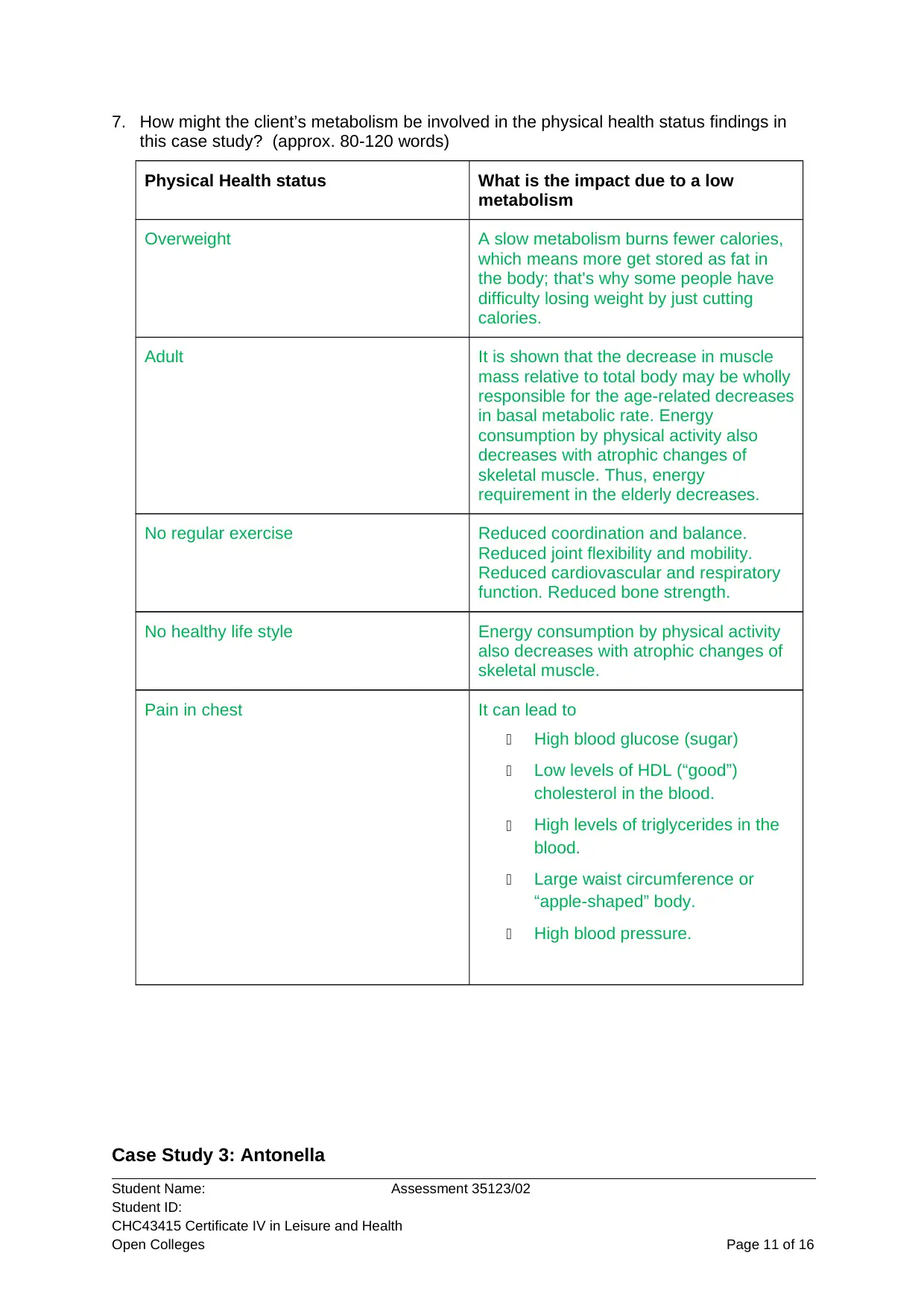
7. How might the client’s metabolism be involved in the physical health status findings in
this case study? (approx. 80-120 words)
Physical Health status What is the impact due to a low
metabolism
Overweight A slow metabolism burns fewer calories,
which means more get stored as fat in
the body; that's why some people have
difficulty losing weight by just cutting
calories.
Adult It is shown that the decrease in muscle
mass relative to total body may be wholly
responsible for the age-related decreases
in basal metabolic rate. Energy
consumption by physical activity also
decreases with atrophic changes of
skeletal muscle. Thus, energy
requirement in the elderly decreases.
No regular exercise Reduced coordination and balance.
Reduced joint flexibility and mobility.
Reduced cardiovascular and respiratory
function. Reduced bone strength.
No healthy life style Energy consumption by physical activity
also decreases with atrophic changes of
skeletal muscle.
Pain in chest It can lead to
High blood glucose (sugar)
Low levels of HDL (“good”)
cholesterol in the blood.
High levels of triglycerides in the
blood.
Large waist circumference or
“apple-shaped” body.
High blood pressure.
Case Study 3: Antonella
Student Name: Assessment 35123/02
Student ID:
CHC43415 Certificate IV in Leisure and Health
Open Colleges Page 11 of 16
this case study? (approx. 80-120 words)
Physical Health status What is the impact due to a low
metabolism
Overweight A slow metabolism burns fewer calories,
which means more get stored as fat in
the body; that's why some people have
difficulty losing weight by just cutting
calories.
Adult It is shown that the decrease in muscle
mass relative to total body may be wholly
responsible for the age-related decreases
in basal metabolic rate. Energy
consumption by physical activity also
decreases with atrophic changes of
skeletal muscle. Thus, energy
requirement in the elderly decreases.
No regular exercise Reduced coordination and balance.
Reduced joint flexibility and mobility.
Reduced cardiovascular and respiratory
function. Reduced bone strength.
No healthy life style Energy consumption by physical activity
also decreases with atrophic changes of
skeletal muscle.
Pain in chest It can lead to
High blood glucose (sugar)
Low levels of HDL (“good”)
cholesterol in the blood.
High levels of triglycerides in the
blood.
Large waist circumference or
“apple-shaped” body.
High blood pressure.
Case Study 3: Antonella
Student Name: Assessment 35123/02
Student ID:
CHC43415 Certificate IV in Leisure and Health
Open Colleges Page 11 of 16
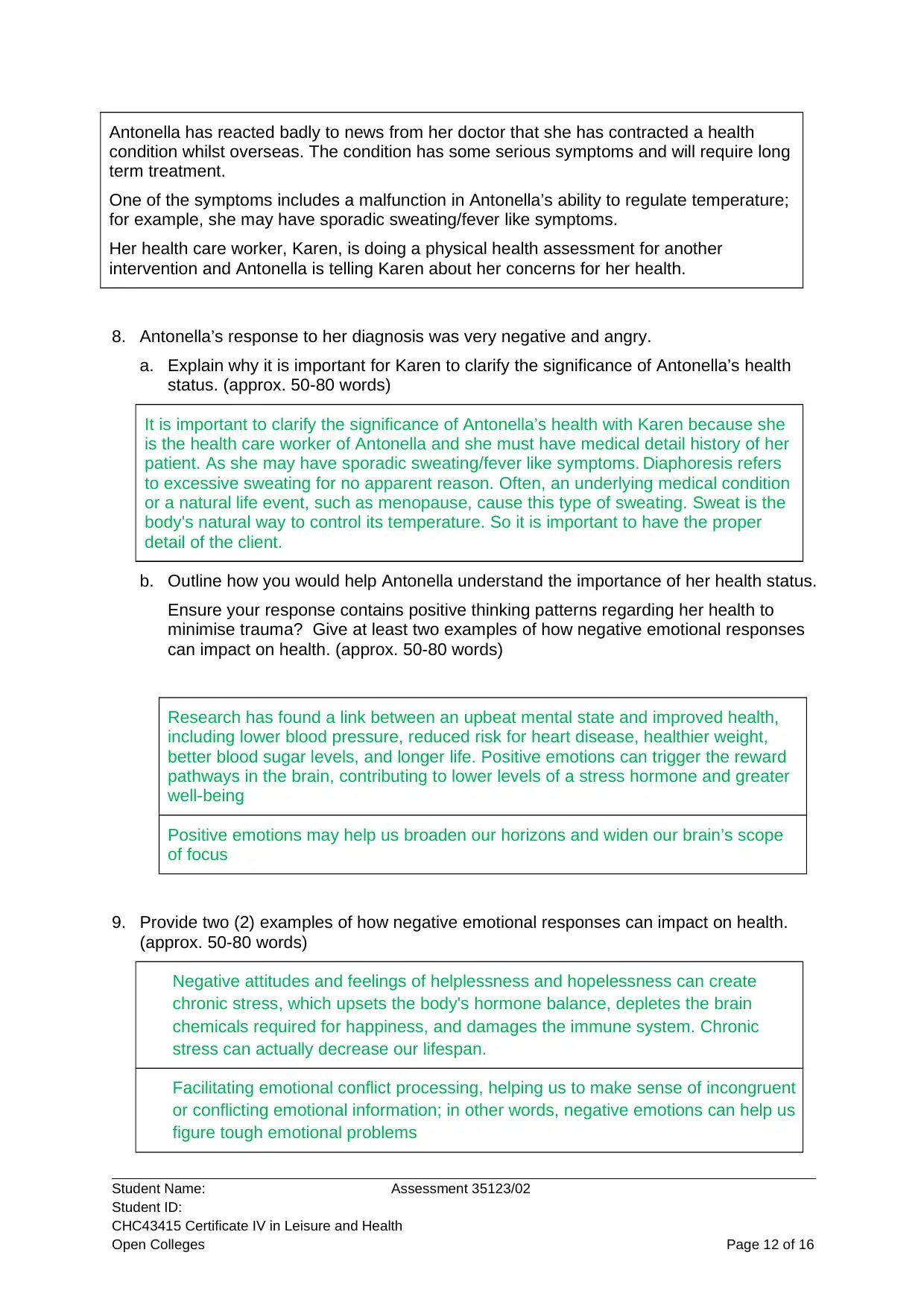
Antonella has reacted badly to news from her doctor that she has contracted a health
condition whilst overseas. The condition has some serious symptoms and will require long
term treatment.
One of the symptoms includes a malfunction in Antonella’s ability to regulate temperature;
for example, she may have sporadic sweating/fever like symptoms.
Her health care worker, Karen, is doing a physical health assessment for another
intervention and Antonella is telling Karen about her concerns for her health.
8. Antonella’s response to her diagnosis was very negative and angry.
a. Explain why it is important for Karen to clarify the significance of Antonella’s health
status. (approx. 50-80 words)
It is important to clarify the significance of Antonella’s health with Karen because she
is the health care worker of Antonella and she must have medical detail history of her
patient. As she may have sporadic sweating/fever like symptoms. Diaphoresis refers
to excessive sweating for no apparent reason. Often, an underlying medical condition
or a natural life event, such as menopause, cause this type of sweating. Sweat is the
body's natural way to control its temperature. So it is important to have the proper
detail of the client.
b. Outline how you would help Antonella understand the importance of her health status.
Ensure your response contains positive thinking patterns regarding her health to
minimise trauma? Give at least two examples of how negative emotional responses
can impact on health. (approx. 50-80 words)
Research has found a link between an upbeat mental state and improved health,
including lower blood pressure, reduced risk for heart disease, healthier weight,
better blood sugar levels, and longer life. Positive emotions can trigger the reward
pathways in the brain, contributing to lower levels of a stress hormone and greater
well-being
Positive emotions may help us broaden our horizons and widen our brain’s scope
of focus
9. Provide two (2) examples of how negative emotional responses can impact on health.
(approx. 50-80 words)
Negative attitudes and feelings of helplessness and hopelessness can create
chronic stress, which upsets the body's hormone balance, depletes the brain
chemicals required for happiness, and damages the immune system. Chronic
stress can actually decrease our lifespan.
Facilitating emotional conflict processing, helping us to make sense of incongruent
or conflicting emotional information; in other words, negative emotions can help us
figure tough emotional problems
Student Name: Assessment 35123/02
Student ID:
CHC43415 Certificate IV in Leisure and Health
Open Colleges Page 12 of 16
condition whilst overseas. The condition has some serious symptoms and will require long
term treatment.
One of the symptoms includes a malfunction in Antonella’s ability to regulate temperature;
for example, she may have sporadic sweating/fever like symptoms.
Her health care worker, Karen, is doing a physical health assessment for another
intervention and Antonella is telling Karen about her concerns for her health.
8. Antonella’s response to her diagnosis was very negative and angry.
a. Explain why it is important for Karen to clarify the significance of Antonella’s health
status. (approx. 50-80 words)
It is important to clarify the significance of Antonella’s health with Karen because she
is the health care worker of Antonella and she must have medical detail history of her
patient. As she may have sporadic sweating/fever like symptoms. Diaphoresis refers
to excessive sweating for no apparent reason. Often, an underlying medical condition
or a natural life event, such as menopause, cause this type of sweating. Sweat is the
body's natural way to control its temperature. So it is important to have the proper
detail of the client.
b. Outline how you would help Antonella understand the importance of her health status.
Ensure your response contains positive thinking patterns regarding her health to
minimise trauma? Give at least two examples of how negative emotional responses
can impact on health. (approx. 50-80 words)
Research has found a link between an upbeat mental state and improved health,
including lower blood pressure, reduced risk for heart disease, healthier weight,
better blood sugar levels, and longer life. Positive emotions can trigger the reward
pathways in the brain, contributing to lower levels of a stress hormone and greater
well-being
Positive emotions may help us broaden our horizons and widen our brain’s scope
of focus
9. Provide two (2) examples of how negative emotional responses can impact on health.
(approx. 50-80 words)
Negative attitudes and feelings of helplessness and hopelessness can create
chronic stress, which upsets the body's hormone balance, depletes the brain
chemicals required for happiness, and damages the immune system. Chronic
stress can actually decrease our lifespan.
Facilitating emotional conflict processing, helping us to make sense of incongruent
or conflicting emotional information; in other words, negative emotions can help us
figure tough emotional problems
Student Name: Assessment 35123/02
Student ID:
CHC43415 Certificate IV in Leisure and Health
Open Colleges Page 12 of 16

10.
Student Name: Assessment 35123/02
Student ID:
CHC43415 Certificate IV in Leisure and Health
Open Colleges Page 13 of 16
Student Name: Assessment 35123/02
Student ID:
CHC43415 Certificate IV in Leisure and Health
Open Colleges Page 13 of 16
Paraphrase This Document
Need a fresh take? Get an instant paraphrase of this document with our AI Paraphraser
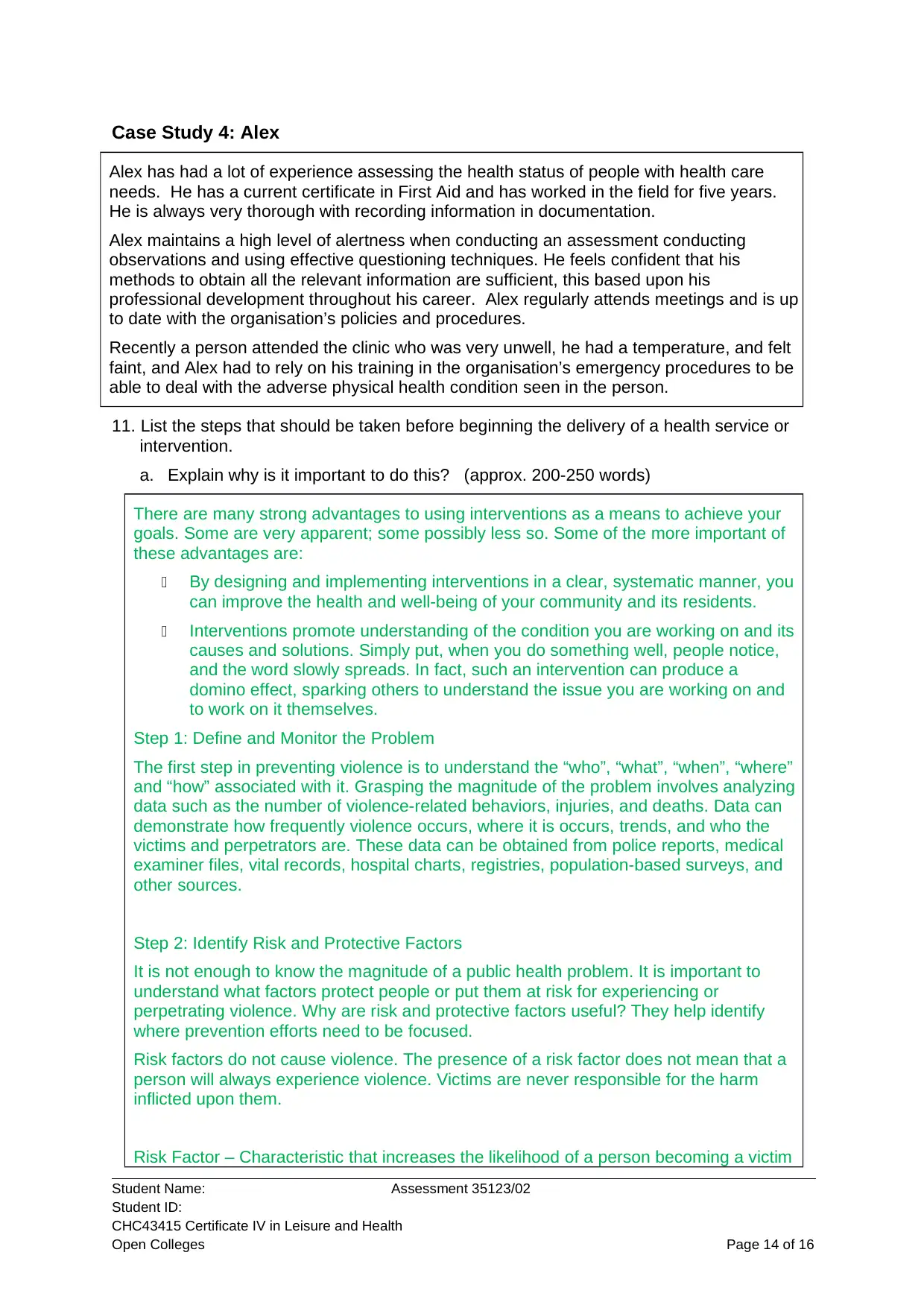
Case Study 4: Alex
Alex has had a lot of experience assessing the health status of people with health care
needs. He has a current certificate in First Aid and has worked in the field for five years.
He is always very thorough with recording information in documentation.
Alex maintains a high level of alertness when conducting an assessment conducting
observations and using effective questioning techniques. He feels confident that his
methods to obtain all the relevant information are sufficient, this based upon his
professional development throughout his career. Alex regularly attends meetings and is up
to date with the organisation’s policies and procedures.
Recently a person attended the clinic who was very unwell, he had a temperature, and felt
faint, and Alex had to rely on his training in the organisation’s emergency procedures to be
able to deal with the adverse physical health condition seen in the person.
11. List the steps that should be taken before beginning the delivery of a health service or
intervention.
a. Explain why is it important to do this? (approx. 200-250 words)
There are many strong advantages to using interventions as a means to achieve your
goals. Some are very apparent; some possibly less so. Some of the more important of
these advantages are:
By designing and implementing interventions in a clear, systematic manner, you
can improve the health and well-being of your community and its residents.
Interventions promote understanding of the condition you are working on and its
causes and solutions. Simply put, when you do something well, people notice,
and the word slowly spreads. In fact, such an intervention can produce a
domino effect, sparking others to understand the issue you are working on and
to work on it themselves.
Step 1: Define and Monitor the Problem
The first step in preventing violence is to understand the “who”, “what”, “when”, “where”
and “how” associated with it. Grasping the magnitude of the problem involves analyzing
data such as the number of violence-related behaviors, injuries, and deaths. Data can
demonstrate how frequently violence occurs, where it is occurs, trends, and who the
victims and perpetrators are. These data can be obtained from police reports, medical
examiner files, vital records, hospital charts, registries, population-based surveys, and
other sources.
Step 2: Identify Risk and Protective Factors
It is not enough to know the magnitude of a public health problem. It is important to
understand what factors protect people or put them at risk for experiencing or
perpetrating violence. Why are risk and protective factors useful? They help identify
where prevention efforts need to be focused.
Risk factors do not cause violence. The presence of a risk factor does not mean that a
person will always experience violence. Victims are never responsible for the harm
inflicted upon them.
Risk Factor – Characteristic that increases the likelihood of a person becoming a victim
Student Name: Assessment 35123/02
Student ID:
CHC43415 Certificate IV in Leisure and Health
Open Colleges Page 14 of 16
Alex has had a lot of experience assessing the health status of people with health care
needs. He has a current certificate in First Aid and has worked in the field for five years.
He is always very thorough with recording information in documentation.
Alex maintains a high level of alertness when conducting an assessment conducting
observations and using effective questioning techniques. He feels confident that his
methods to obtain all the relevant information are sufficient, this based upon his
professional development throughout his career. Alex regularly attends meetings and is up
to date with the organisation’s policies and procedures.
Recently a person attended the clinic who was very unwell, he had a temperature, and felt
faint, and Alex had to rely on his training in the organisation’s emergency procedures to be
able to deal with the adverse physical health condition seen in the person.
11. List the steps that should be taken before beginning the delivery of a health service or
intervention.
a. Explain why is it important to do this? (approx. 200-250 words)
There are many strong advantages to using interventions as a means to achieve your
goals. Some are very apparent; some possibly less so. Some of the more important of
these advantages are:
By designing and implementing interventions in a clear, systematic manner, you
can improve the health and well-being of your community and its residents.
Interventions promote understanding of the condition you are working on and its
causes and solutions. Simply put, when you do something well, people notice,
and the word slowly spreads. In fact, such an intervention can produce a
domino effect, sparking others to understand the issue you are working on and
to work on it themselves.
Step 1: Define and Monitor the Problem
The first step in preventing violence is to understand the “who”, “what”, “when”, “where”
and “how” associated with it. Grasping the magnitude of the problem involves analyzing
data such as the number of violence-related behaviors, injuries, and deaths. Data can
demonstrate how frequently violence occurs, where it is occurs, trends, and who the
victims and perpetrators are. These data can be obtained from police reports, medical
examiner files, vital records, hospital charts, registries, population-based surveys, and
other sources.
Step 2: Identify Risk and Protective Factors
It is not enough to know the magnitude of a public health problem. It is important to
understand what factors protect people or put them at risk for experiencing or
perpetrating violence. Why are risk and protective factors useful? They help identify
where prevention efforts need to be focused.
Risk factors do not cause violence. The presence of a risk factor does not mean that a
person will always experience violence. Victims are never responsible for the harm
inflicted upon them.
Risk Factor – Characteristic that increases the likelihood of a person becoming a victim
Student Name: Assessment 35123/02
Student ID:
CHC43415 Certificate IV in Leisure and Health
Open Colleges Page 14 of 16
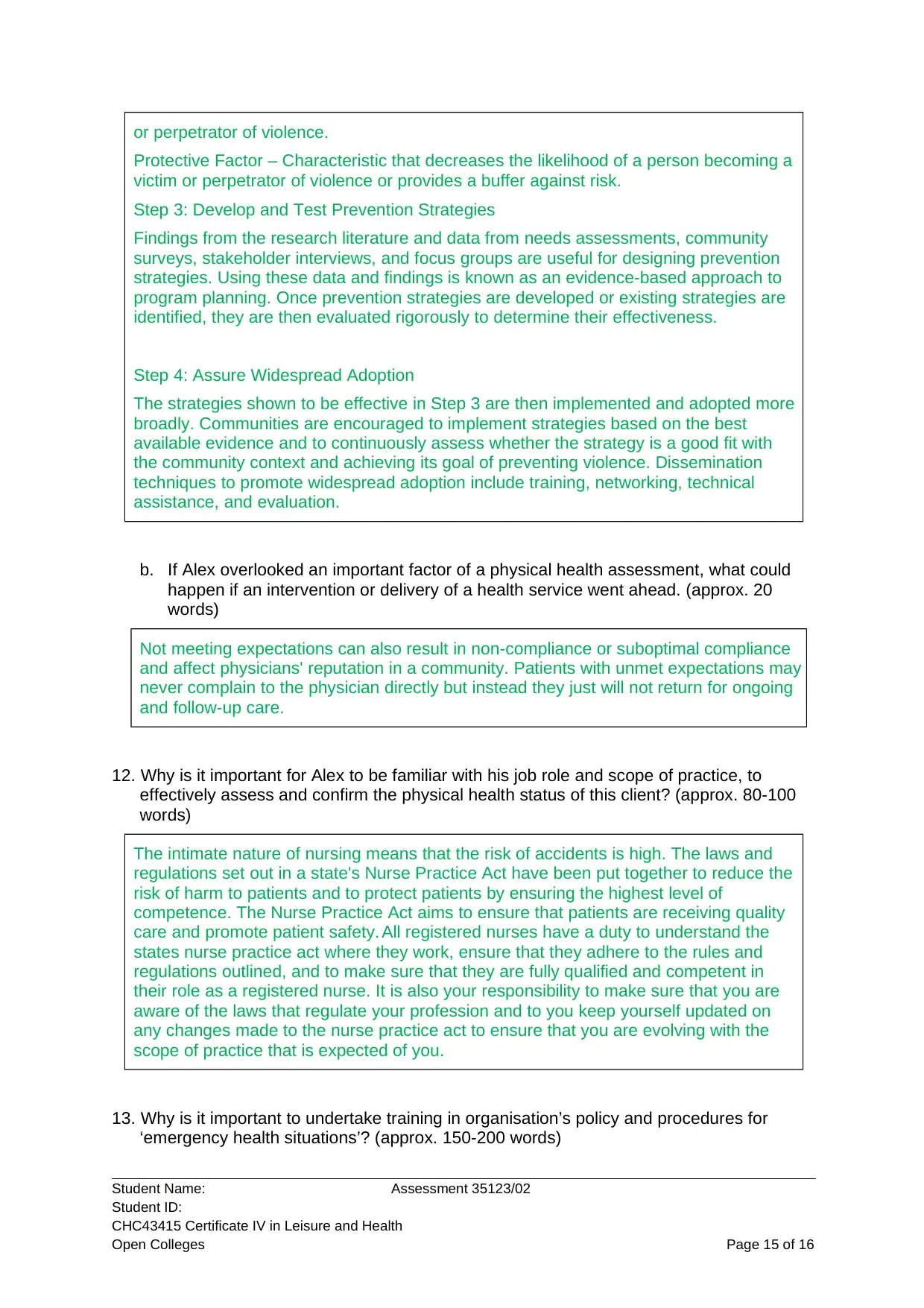
or perpetrator of violence.
Protective Factor – Characteristic that decreases the likelihood of a person becoming a
victim or perpetrator of violence or provides a buffer against risk.
Step 3: Develop and Test Prevention Strategies
Findings from the research literature and data from needs assessments, community
surveys, stakeholder interviews, and focus groups are useful for designing prevention
strategies. Using these data and findings is known as an evidence-based approach to
program planning. Once prevention strategies are developed or existing strategies are
identified, they are then evaluated rigorously to determine their effectiveness.
Step 4: Assure Widespread Adoption
The strategies shown to be effective in Step 3 are then implemented and adopted more
broadly. Communities are encouraged to implement strategies based on the best
available evidence and to continuously assess whether the strategy is a good fit with
the community context and achieving its goal of preventing violence. Dissemination
techniques to promote widespread adoption include training, networking, technical
assistance, and evaluation.
b. If Alex overlooked an important factor of a physical health assessment, what could
happen if an intervention or delivery of a health service went ahead. (approx. 20
words)
Not meeting expectations can also result in non-compliance or suboptimal compliance
and affect physicians' reputation in a community. Patients with unmet expectations may
never complain to the physician directly but instead they just will not return for ongoing
and follow-up care.
12. Why is it important for Alex to be familiar with his job role and scope of practice, to
effectively assess and confirm the physical health status of this client? (approx. 80-100
words)
The intimate nature of nursing means that the risk of accidents is high. The laws and
regulations set out in a state's Nurse Practice Act have been put together to reduce the
risk of harm to patients and to protect patients by ensuring the highest level of
competence. The Nurse Practice Act aims to ensure that patients are receiving quality
care and promote patient safety. All registered nurses have a duty to understand the
states nurse practice act where they work, ensure that they adhere to the rules and
regulations outlined, and to make sure that they are fully qualified and competent in
their role as a registered nurse. It is also your responsibility to make sure that you are
aware of the laws that regulate your profession and to you keep yourself updated on
any changes made to the nurse practice act to ensure that you are evolving with the
scope of practice that is expected of you.
13. Why is it important to undertake training in organisation’s policy and procedures for
‘emergency health situations’? (approx. 150-200 words)
Student Name: Assessment 35123/02
Student ID:
CHC43415 Certificate IV in Leisure and Health
Open Colleges Page 15 of 16
Protective Factor – Characteristic that decreases the likelihood of a person becoming a
victim or perpetrator of violence or provides a buffer against risk.
Step 3: Develop and Test Prevention Strategies
Findings from the research literature and data from needs assessments, community
surveys, stakeholder interviews, and focus groups are useful for designing prevention
strategies. Using these data and findings is known as an evidence-based approach to
program planning. Once prevention strategies are developed or existing strategies are
identified, they are then evaluated rigorously to determine their effectiveness.
Step 4: Assure Widespread Adoption
The strategies shown to be effective in Step 3 are then implemented and adopted more
broadly. Communities are encouraged to implement strategies based on the best
available evidence and to continuously assess whether the strategy is a good fit with
the community context and achieving its goal of preventing violence. Dissemination
techniques to promote widespread adoption include training, networking, technical
assistance, and evaluation.
b. If Alex overlooked an important factor of a physical health assessment, what could
happen if an intervention or delivery of a health service went ahead. (approx. 20
words)
Not meeting expectations can also result in non-compliance or suboptimal compliance
and affect physicians' reputation in a community. Patients with unmet expectations may
never complain to the physician directly but instead they just will not return for ongoing
and follow-up care.
12. Why is it important for Alex to be familiar with his job role and scope of practice, to
effectively assess and confirm the physical health status of this client? (approx. 80-100
words)
The intimate nature of nursing means that the risk of accidents is high. The laws and
regulations set out in a state's Nurse Practice Act have been put together to reduce the
risk of harm to patients and to protect patients by ensuring the highest level of
competence. The Nurse Practice Act aims to ensure that patients are receiving quality
care and promote patient safety. All registered nurses have a duty to understand the
states nurse practice act where they work, ensure that they adhere to the rules and
regulations outlined, and to make sure that they are fully qualified and competent in
their role as a registered nurse. It is also your responsibility to make sure that you are
aware of the laws that regulate your profession and to you keep yourself updated on
any changes made to the nurse practice act to ensure that you are evolving with the
scope of practice that is expected of you.
13. Why is it important to undertake training in organisation’s policy and procedures for
‘emergency health situations’? (approx. 150-200 words)
Student Name: Assessment 35123/02
Student ID:
CHC43415 Certificate IV in Leisure and Health
Open Colleges Page 15 of 16
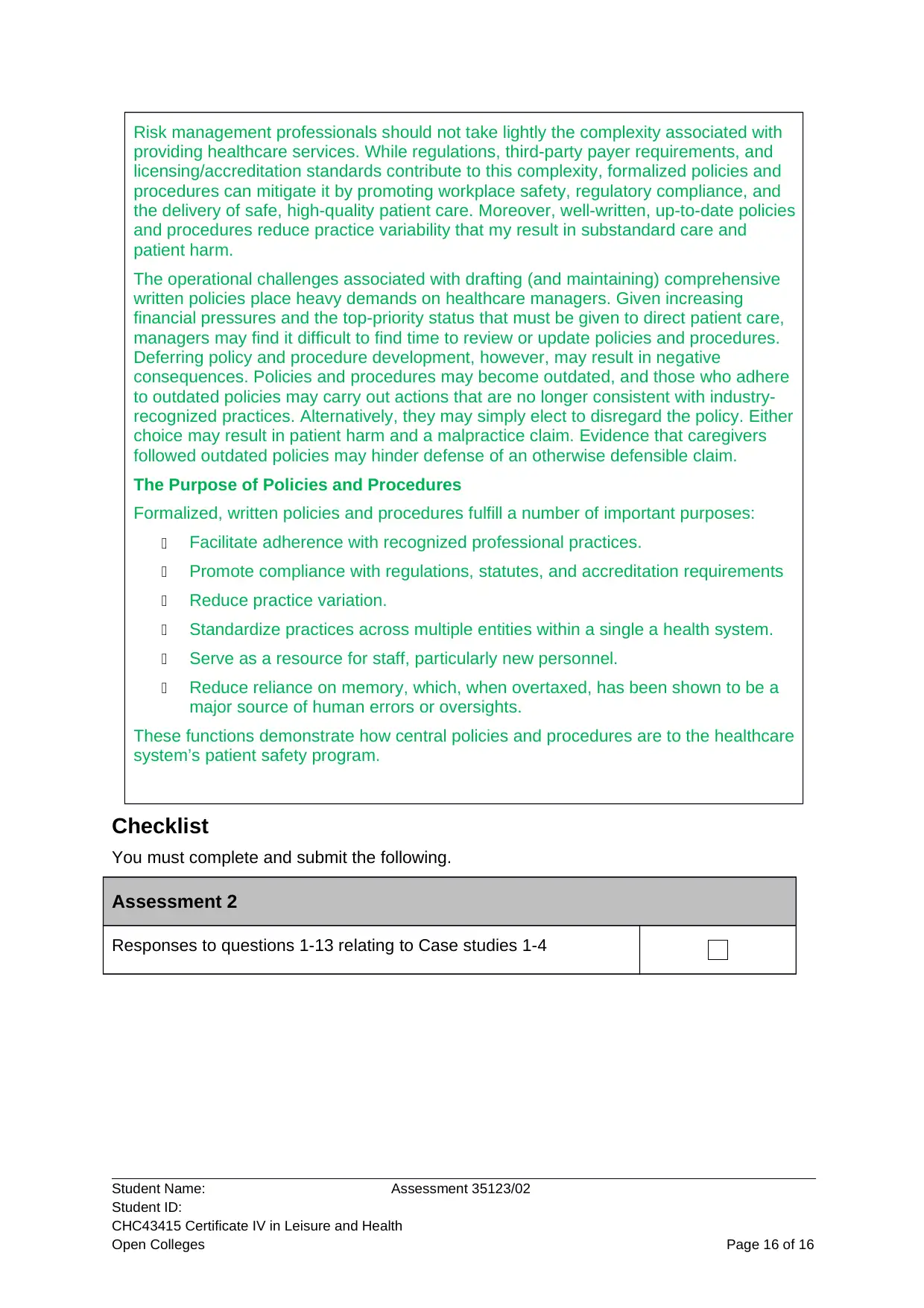
Risk management professionals should not take lightly the complexity associated with
providing healthcare services. While regulations, third-party payer requirements, and
licensing/accreditation standards contribute to this complexity, formalized policies and
procedures can mitigate it by promoting workplace safety, regulatory compliance, and
the delivery of safe, high-quality patient care. Moreover, well-written, up-to-date policies
and procedures reduce practice variability that my result in substandard care and
patient harm.
The operational challenges associated with drafting (and maintaining) comprehensive
written policies place heavy demands on healthcare managers. Given increasing
financial pressures and the top-priority status that must be given to direct patient care,
managers may find it difficult to find time to review or update policies and procedures.
Deferring policy and procedure development, however, may result in negative
consequences. Policies and procedures may become outdated, and those who adhere
to outdated policies may carry out actions that are no longer consistent with industry-
recognized practices. Alternatively, they may simply elect to disregard the policy. Either
choice may result in patient harm and a malpractice claim. Evidence that caregivers
followed outdated policies may hinder defense of an otherwise defensible claim.
The Purpose of Policies and Procedures
Formalized, written policies and procedures fulfill a number of important purposes:
Facilitate adherence with recognized professional practices.
Promote compliance with regulations, statutes, and accreditation requirements
Reduce practice variation.
Standardize practices across multiple entities within a single a health system.
Serve as a resource for staff, particularly new personnel.
Reduce reliance on memory, which, when overtaxed, has been shown to be a
major source of human errors or oversights.
These functions demonstrate how central policies and procedures are to the healthcare
system’s patient safety program.
Checklist
You must complete and submit the following.
Assessment 2
Responses to questions 1-13 relating to Case studies 1-4
Student Name: Assessment 35123/02
Student ID:
CHC43415 Certificate IV in Leisure and Health
Open Colleges Page 16 of 16
providing healthcare services. While regulations, third-party payer requirements, and
licensing/accreditation standards contribute to this complexity, formalized policies and
procedures can mitigate it by promoting workplace safety, regulatory compliance, and
the delivery of safe, high-quality patient care. Moreover, well-written, up-to-date policies
and procedures reduce practice variability that my result in substandard care and
patient harm.
The operational challenges associated with drafting (and maintaining) comprehensive
written policies place heavy demands on healthcare managers. Given increasing
financial pressures and the top-priority status that must be given to direct patient care,
managers may find it difficult to find time to review or update policies and procedures.
Deferring policy and procedure development, however, may result in negative
consequences. Policies and procedures may become outdated, and those who adhere
to outdated policies may carry out actions that are no longer consistent with industry-
recognized practices. Alternatively, they may simply elect to disregard the policy. Either
choice may result in patient harm and a malpractice claim. Evidence that caregivers
followed outdated policies may hinder defense of an otherwise defensible claim.
The Purpose of Policies and Procedures
Formalized, written policies and procedures fulfill a number of important purposes:
Facilitate adherence with recognized professional practices.
Promote compliance with regulations, statutes, and accreditation requirements
Reduce practice variation.
Standardize practices across multiple entities within a single a health system.
Serve as a resource for staff, particularly new personnel.
Reduce reliance on memory, which, when overtaxed, has been shown to be a
major source of human errors or oversights.
These functions demonstrate how central policies and procedures are to the healthcare
system’s patient safety program.
Checklist
You must complete and submit the following.
Assessment 2
Responses to questions 1-13 relating to Case studies 1-4
Student Name: Assessment 35123/02
Student ID:
CHC43415 Certificate IV in Leisure and Health
Open Colleges Page 16 of 16
1 out of 16
Related Documents
Your All-in-One AI-Powered Toolkit for Academic Success.
+13062052269
info@desklib.com
Available 24*7 on WhatsApp / Email
![[object Object]](/_next/static/media/star-bottom.7253800d.svg)
Unlock your academic potential
© 2024 | Zucol Services PVT LTD | All rights reserved.




